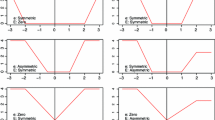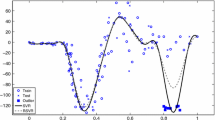Abstract
The classical support vector machine (SVM) is sensitive to outliers. This paper proposes a robust support vector regression based on a generalized non-convex loss function with flexible slope and margin. The robust model is more flexible for regression estimation. Meanwhile, it has strong ability of suppressing the impact of outliers. The generalized loss function is neither convex nor differentiable. We approximate it by combining two differentiable Huber functions, and the resultant optimization problem is a difference of convex functions (d.c.) program. We develop a Newton algorithm to solve the robust model. The numerical experiments on benchmark datasets, financial time series datasets and document retrieval dataset confirm the robustness and effectiveness of the proposed method. It also reduces the downside risk in financial time series prediction, and significantly outperforms ranking SVM for performing real information retrieval tasks.






Similar content being viewed by others
References
An LTH, Tao P (2005) The DC (difference of convex functions) programming and DCA revisited with DC models of real world nonconvex optimization problems. Ann Oper Res 133:23–46
Bo L, Wang L, Jiao L (2007) Recursive finite Newton algorithm for support vector regression in the primal. Neural Comput 19(4):1082–1096
Cao Y, Xu J, Liu T, Li H, Huang Y, Hon H (2006). Adapting ranking SVM to document retrieval. In: Proceedings of the 29th annual international ACM SIGIR conference on research and development in information retrieval, pp. 186–193
Cao Z, Qin T, Liu T, Tsai M, Li H (2007) Learning to rank: from pairwise approach to listwise approach. In: Proceedings of the 24th international conference on machine learning (ICML), pp. 129–136
Chang C, Lin C (2001) LIBSVM: a library for support vector machines. http://www.csie.ntu.edu.tw/~cjlin
Chapelle O (2007) Training a support vector machine in the primal. Neural Comput 19(5):1155–1178
Collobert R, Sinz F, Weston J, Bottou L (2006) Trading convexity for scalability. In: Proceeding of the 23rd international conference on machine learning (ICML)
Geng B, Yang Y, Xu C, Hua X (2010) Content-aware ranking for visual search. In: IEEE conference on computer vision and pattern recognition (CVPR), pp. 3400–3407
Huang G, Song S, Wu C, You K (2012) Robust support vector regression for uncertain input and output data. IEEE Trans Neural Netw Learn Syst 23:1690–1700
Huang H, Liu Y (2002) Fuzzy support vector machines for pattern recognition and data mining. Int J Fuzzy Syst 4:3–12
Joachims T, Finley T, Yu C (2009) Cutting-plane training of structural SVMs. Mach Learn 77(1):27–59
Luo Y, Tao D, Geng B, Xu C, Maybank SJ (2013) Manifold regularized multitask learning for semi-supervised multilabel image classification. IEEE Trans Image Process 22(2):523–536
Luo Y, Tao D, Xu C, Xu C, Liu H, Wen Y (2013) Multiview vector-valued manifold regularization for multilabel image classification. IEEE Trans Neural Netw Learn Syst 24(5):709–722
Ong CS, An LTH (2013) Learning sparse classifiers with difference of convex functions algorithms. Optim Methods Softw 28(4):830–854
Osuna E, Freund R, Girosi F (1997) An improved training algorithm for support vector machines. In: Principe J, Gile L, Morgan N, Wilson E (eds) Neural networks for signal processing VII-proceedings of the 1997 IEEE Workshop, pp. 276–285
Peng X (2009) TSVR: an efficient twin support vector machine for regression. Neural Netw 23(3):365–372
Platt JC (1999) Fast training of support vector machines using sequential minimal optimization. In: Schölkopf B, Burges CJC, Smola AJ (eds) Advances in Kernel methods-support vector learning. MIT Press, Cambridge, pp 185–208
Sriperumbudur BK, Lanckriet GRG (2009) On the convergence of the concave–convex procedure. Advances in neural information processing systems, pp. 1759–1767
Suykens J, DeBrabanter J, Lukas L (2002) Weighted least squares support vector machines: robustness and sparse approximation. Neurocomputing 48:85–105
Tao P, An LTH (1998) D.c. optimization algorithms for solving the trust region subproblem. SIAM J Optim 8:476–505
Trafalis B, Gilbert C (2006) Robust classification and regression using support vector machines. Eur J Operat Res 173:893–909
Tsochantaridis I, Joachims T, Hofmann T, Altun Y (2005) Large margin methods for structured and interdependent output variables. J Mach Learn Res 6:1453–1484
Vapnik VN (1995) The nature of statistical learning theory. Springer, New York
Wang K, Zhong P, Zhao Y (2010) Training robust support vector regression via d.c. program. J Inf Comput Sci 7(12):2385–2394
Wang L, Jia H, Li J (2008) Training robust support vector machine with smooth ramp loss in the primal space. Neurocomputing 71(13–15):3020–3025
Wu Y, Liu Y (2007) Robust truncated hinge loss support vector machines. J Am Stat Assoc 102(479):974–983
Xu L, Crammer K, Schuurmans D (2006) Robust support vector machine training via convex outlier ablation. In: Proceedings of the 21st national conference on artifical Intelligence (AAAI)
Xu Y, Wang L (2012) A weighted twin support vector regression. Knowl-Based Syst 33:92–101
Yang C, Chou J, Lian F (2013) Robust classifier learning with fuzzy class labels for large-margin support vector machines. Neurocomputing 99:1–14
Yang H, Chan L, King I (2002) Support vector machine regression for volatile stock market prediction. In: Proceedings of the third international conference on intelligent data engineering and automated learning, pp. 391–396
Yu J, Wang M, Tao D (2012) Semisupervised multiview distance metric learning for cartoon synthesis. IEEE Trans Image Process 21(11):4636–4648
Yu J, Tao D, Wang M (2012) Adaptive hypergraph learning and its application in image classification. IEEE Trans Image Process 21(7):3262–3272
Yu J, Tao D (2013) Modern machine learning techniques and their applications in cartoon animation research. Wiley, Hoboken
Yu J, Liu D, Tao D, Seah H (2011) Complex object correspondence construction in two-dimensional animation. IEEE Trans Image Process 20(11):3257–3269
Yuille AL, Rangarajan A (2003) The concave–convex procedure. Neural Comput 15(4):915–936
Zhao Y, Sun J (2008) Robust support vector regression in the primal. Neural Netw 21(10):1548–1555
Zhong P (2012) Training robust support vector regression with smooth non-convex loss function. Optim Methods Softw 27(6):1039–1058
Zhong P, Fukushima M (2007) Second order cone programming formulations for robust multi-class classification. Neural Comput 19:258–282
Zhong P, Wang L (2008) Support vector regression with input data uncertainty. Int J Innov Comput Inf Control 4:2325–2332
Liu W, Tao D (2013) Multiview Hessian regularization for image annotation. IEEE Trans Image Process 22(7):2676–2687
Herbrich R, Graepel T, Obermayer K (1999) Large margin rank boundaries for ordinal regression. Advances in neural information processing systems. MIT Press, Cambridge, pp 115–132
Järvelin K, Kekäläinen J (2000) IR evaluation methods for retrieving highly relevant documents. In: Proceedings of the 23rd annual international ACM SIGIR conference on research and development in information retrieval, pp. 41–48
Qin T, Liu T, Xu J, Li H (2010) Letor: a benchmark collection for research on learning to rank for information retrieval. Inf Retr 13(4):346–374
Hersh W, Buckley C, Leone T, Hickam D (1994) OHSUMED: an interactive retrieval evaluation and new large test collection for research. In: Proceedings of the 17th annual ACM SIGIR conference, pp. 192–201.
Acknowledgments
The work is supported by National Natural Science Foundation of China Grant No.11171346 and Chinese Universities Scientific Fund No.2013YJ010. The authors also gratefully acknowledge the helpful comments and suggestions of the reviewers, which have improved the presentation.
Author information
Authors and Affiliations
Corresponding author
Rights and permissions
About this article
Cite this article
Wang, K., Zhu, W. & Zhong, P. Robust Support Vector Regression with Generalized Loss Function and Applications. Neural Process Lett 41, 89–106 (2015). https://doi.org/10.1007/s11063-013-9336-3
Published:
Issue Date:
DOI: https://doi.org/10.1007/s11063-013-9336-3




